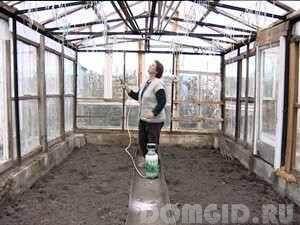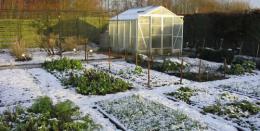Search
Login
Recommended
Preparing the greenhouse for the winter, processing and disinfection of the greenhouse in the fall, reinforcing the frame
Although it’s autumn in the courtyard, the owners of greenhouses can not worry about raising prices for vegetable products - with proper care, even in an unheated greenhouse you can get a good harvest. Of course, for this you will have to work hard, and most importantly - correctly and in a timely manner to apply the most modern methods of plant fertilizer and their treatment with effective drugs. Experienced gardeners argue that not even in the most favorable weather conditions for the summer, during the season with 10 square meters. m greenhouses can be obtained about one and a half centners of cucumbers. The yield indicator is also affected by the conditions of the climatic zone in which vegetables are grown.
Content
- Growing cucumbers in a greenhouse in autumn video
- Greenhouse in the fall - what work should be done before the onset of cold weather
- How to clean greenhouses after the last harvest
- Soil disinfection video
- Digging soil
- Removable cover greenhouse care
- How to strengthen the frame of the greenhouse
- How to prepare a tomato greenhouse for wintering video
Growing cucumbers in a greenhouse in autumn

A very important point in the successful cultivation of cucumbers is the timely introduction of full-fledged organic and mineral fertilizing. But even with proper care at the end of August, there may be a deterioration in leaf growth, a massive appearance of spots on them. Therefore, plants should definitely be sprayed with Epin, and the root system should be fed with slurry with the addition of urea.
After a while, the plants recover, resume fruiting. The rational care of cucumbers in the greenhouse in the fall is as follows:
- adding fresh soil to the root system to prevent exposure of the roots,
- puncturing the soil with a pitchfork - to ensure active air flow to the roots of the plant
- since the central shoot has already worked out in the summer, it can be unloaded from the leaves.
This will provoke activation of the development of lateral shoots and increase the number of ovaries on them. The top of the central shoot will develop more actively.
If we talk about varieties that can bear fruit until late autumn, then we should recall the hybrids of Valentine, Vernissage, Opla, Druzhok, Severny. If necessary, then in the greenhouse, along with cucumbers in the autumn, you can contain sweet pepper.

The fruiting of cucumbers in an unheated greenhouse in the autumn usually continues until the end of September - beginning of October. In addition to cucumbers in the greenhouse in autumn, you can get a good crop of parsley and dill, lettuce - these plants develop well at moderate temperatures, provided that the soil is sufficiently moistened.
Greenhouse in the fall - what work should be done before the onset of cold weather
Harvesting the last crop and removing plant residues from the greenhouse does not mean at all that the owners can indulge in rest. It is during this period that you will need to work a little more and how to properly prepare the greenhouse for wintering and for the next season. If the question of preparation is approached correctly, then by the next spring you can get rich in nutrients, soft and loose soil, sufficiently moistened and saturated with oxygen. Even if the plants were not sick, it would still be necessary to process the greenhouse in the fall anyway - this would rid the soil of viruses of fungal infections, various pests. Also, in connection with the upcoming winter, it will be necessary to install additional supports on the frame.
How to clean greenhouses after the last harvest

The very first thing that needs to be done is to remove all the remains of plants and their roots, it is also recommended to remove the top layer of soil - from 5 to 7 cm and take it out. Do not ignore harmful insects and their larvae, which can damage seedlings in the spring of next year. For example, to get rid of the bear, it will be enough to dig the beds deep enough. It will be much more difficult to get rid of the larvae of the May beetle - they can be destroyed only by physical means. To do this, you need to dig and sift the soil in the greenhouse. Even from severe frost, wireworm larvae will not disappear, they are not afraid of digging the ground either. Until the frosts come, you should also clean the walls of the greenhouse from dust and dirt accumulated over the summer. Then you can do the soil cultivation.
Soil disinfection

It is in the fall that it is advisable to get rid of the structures of the causative agents of fungal and viral diseases that have accumulated in the soil and in wooden structures. A very effective procedure is fumigation of the greenhouse with sulfur. To do this, you will need 100 g of sulfur or smoke bombs weighing 60 g per square meter. Sulfur or checkers are placed on metal sheets inside the greenhouse, set on fire. To protect yourself from harmful fumes, you should work in a gas mask and follow all the rules for handling combustible materials.
A greenhouse with smoking checkers is left tightly closed for 1 hour.
To enhance the efficiency of fumigation, the surface of the walls of the greenhouse, the racks inside it, are well moistened. After processing, the greenhouse is opened for ventilation.
All glass surfaces are washed with water with the addition of pemoxols (1 - 2% solution). It is easiest to apply the solution with a sprayer, then the surface is wiped with nylon brushes, washed thoroughly with water from a hose. In the fall, polycarbonate greenhouses are disinfected in the same way as glass. Some gardeners have successfully used the same method to process their cellars.
Digging soil

Then you can start digging the soil, then - evenly cover the entire surface of the soil with a layer of humus and peat, for each meter square. half a bucket of organic fertilizer should be applied. Based on 1 square. m is deposited on a liter bank of river sand and ash.

The soil surface is covered with straw, with the onset of winter snow is introduced into the greenhouse. He will prevent freezing of the soil, and with the onset of winter he will saturate it with melt water.
Removable cover greenhouse care
If the cover of the greenhouse is removable, from a plastic film, then initially you will need to wash the film and dry it thoroughly. Only then carefully remove the film. It is advisable to remove the polyethylene coating from greenhouses for the winter - even its durable types do not withstand the effects of low temperatures and quickly collapse.

After this, the frame of the structure is treated with a solution of bleach. The solution is prepared at the rate of 400 grams of lime per 10 liters of water. Insist lime for 4 hours, while periodically mixed. The liquid that settles on top is used to spray the soil, the material of the structures is treated with a brush using a sediment mixture. All equipment that is used in the greenhouse should also be treated with a solution of bleach. The wooden structure can be treated with a mixture of freshly slaked lime and copper sulphate. The treated surfaces will retain their color for a long time, in the greenhouse after such processing it becomes clean and light.
To process high-quality galvanized steel, special tools will not be required - you can use the same lime mortar. If the design does not have galvanized hardware (door hinges, handles, latches), it is covered with a layer of paint.

If the greenhouse is constructed from painted or unpainted material of a different origin, then it will not be possible to do without special treatment and painting. Otherwise, the corrosion processes will slowly destroy the structure.
All cups for growing seedlings and boxes, other containers must be poured with boiling water.
How to strengthen the frame of the greenhouse

If the construction of the greenhouse was carried out with their own hands, often without special engineering calculations of strength, then one can quite reasonably be afraid of damage to snow accumulating on the roof. However, a negative accumulation of snow masses on the roofs of purchased super durable greenhouses can have negative consequences. Hope that virtually weightless snowflakes cannot damage the solid structure should not be - even the double construction of the so-called Kremlin greenhouse, which can easily withstand the weight of several people, can also be destroyed. During heavy snowfall, such an amount is accumulated that its pressure can reach critical figures exceeding a ton per square meter. m. If these indicators are compared with the figures indicated in the passport of the purchased greenhouse, then the cause of the damage is easy to understand - the bearing capacity of their structures reaches from 200 to 500 kg / sq. m.

Therefore, strengthening the greenhouse with additional supports will not be amiss even in the case of a not very snowy winter. You can use additional arcs, sometimes they are offered to purchase along with a greenhouse. You can also use wooden props in the shape of T. You can make them yourself. They are able to create sufficient support for the ridge of the greenhouse.

It is important to remember that a greenhouse of any strength can withstand the load created by a maximum of 70 cm of fluffy snow or 30 cm of packed snow or wet snow.
It is not difficult to calculate the required number of supports: for a six-meter greenhouse, they will need at least 3-4 pieces. If the greenhouse is located in such a way that there is a threat of creating snow caps, for example, near a high fence or in a leeward place, then twice as many props will be required.

So that the supports do not fall into the ground and do not fall, they are attached to the upper crossbar of the greenhouse structure, and a solid support is placed under their lower end, for example, cuts of a wide wooden board.
How to prepare a tomato greenhouse for wintering

If the greenhouse is designed exclusively for growing tomatoes, then the autumn work is carried out according to the following scheme:
- After harvesting the last crop, all the stems and roots are removed and dried, then burned. Tops damaged by rot or mold cannot be used.
- Ash is collected in a container and stored - it will be needed for fertilizer and pest control.
- Next, the soil is treated with a solution of iron vitriol: 250 g of vitriol are taken on a bucket of water.
The soil is dug in a special way: they dig a row, dry leaves or grass are laid in the resulting groove, sprinkle with earth from the next row. Humidified waste with the onset of spring sunny days will begin to shine and generate heat. This fact will help optimize the temperature in the greenhouse, the tomato roots will receive heating sufficient to actively stimulate the growth and development of seedlings.
Be sure to clean all the grass around the greenhouses - it can arrange their wintering aphids or whiteflies.
After processing the greenhouse in the fall and preparing it for wintering properly, you can safely expect the onset of frost and snowfall. Next year, the greenhouse is sure to please a plentiful harvest of vegetables.





